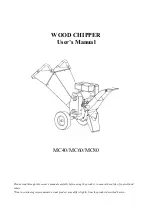
Models 14.4 - 26.4, controller pCO
2
Blue Box - Page 76
8.2.18 Defrost (heat pumps units /LC/HP)
During winter mode operation (heat pump) the the remote condenser finned coil functions as an evaporator,
cooling and dehumidifying ambient air.
During heat pump operation, the evaporation pressure is monitored to prevent it from falling below a preset
value. The evaporation control is active only during heating mode operation.
Depending on the ambient air temperature and humidity conditions, condensate or frost will tend to form,
consequently obstructing the free passage of air and causing thermal insulation. The frost that builds up on the
coil obstructs the passage of air, reduces the available heat exchange surface area (and thus the thermal efficiency),
and can damage the exchanger.
Defrosting is the procedure that serves to prevent or eliminate the formation of ice on the evaporator coil during
heat pump mode operation of an air to water unit.
Defrosting is performed simultaneously for the entire unit.
All heat pump versions are equipped with a control that activates an automatic coil defrost cycle when necessary.
After starting however, the first defrost cycle will be started after a preset minimum operating time to allow the
formation of sufficient thermal inertia to allow the cycle to be completed successfully.
Defrost cycle demands are based on detection of a low suction pressure value, due to the insufficient heat
exchange between the evaporator and the air because of the formation of a layer of ice, which exerts a thermal
insulation effect. For a defrost cycle to be able to start the suction pressure of at least one of the currently
operating compressors must remain below the pressure set for the defrost cycle trip signal for a given time
interval.
Before starting to defrost the coils, all the compressors are started, after which the unit is switched from heat
pump to cooling mode.
When the cycle is reversed the fans stop and the compressors force hot gas into the coil.
A pressure switch on the high pressure circuit maintains the gas discharge pressure below the defrost end value.
To maintain the pressure lower than the defrost end pressure the pressure switch activates the fans.
To reduce the air flow, and obtain more efficient heating of the outer part of the coil, the pressure switch signal
causes the fans to rotate in reverse.
On remote condensers/evaporators supplied by Blue Box when the defrost end temperature is reached, as measured
by a thermostat with the relative sensor located in the lower part of the coil, the pressure switch allows the
delivery pressure to reach the defrost end pressure.
With remote condensers/evaporators not supplied by Blue Box the heat exchanger is controlled by pressure only.
When the defrost end pressure has been reached the controller reverses the unit from chiller mode to heat pump
mode thereby terminating the defrost procedure.
Even though in certain conditions the surface temperature of the coil and the condensation pressure fail to reach
the defrost values, within the preset time limit, the defrost cycle is forcibly terminated as though the defrost end
signal were present. The controller restarts the fans and when the pressure returns to the preset value it reverses
the unit's operating mode again.
If the defrost cycle is forcibly interrupted with the timeout signal it is signalled on the display even though no
8.2.16 Dual set-point (option)
With double thermostatic valves and solenoid valves that are automatically switched according to the required
expansion temperature. Two set-point values can be programmed on the microprocessor controller via the keypad
or a digital input. Switching of the thermostatic valves is always automatic, in accordance with the water tempe-
rature. The valves are sized on the basis of the temperature values specified at the time of the order. The
machine operating limits shown in the catalogue are not affected. If the hydraulic circuit contains glycol in
sufficient quantities to eliminate the risk of freezing, the lower limit is extended to a minimum of -5 °C leaving
water temperature.
8.2.17 Leaving water temperature control (option)
With leaving chilled water temperature control a reference sensor must be installed on the evaporator outlet.
The unit's capacity steps are activated / deactivated with delay intervals in relation to a dead zone. When the
leaving water temperature is higher than the programmed set-point compressors start is enabled.
Summary of Contents for SIGMA 2002
Page 2: ......
Page 99: ...Blue Box 93 REFRIGERANT CIRCUIT DIAGRAM SIGMA 2002 SIGMA 2002 DC MODELS 3 2 13 2...
Page 100: ...Blue Box 94 REFRIGERANT CIRCUIT DIAGRAM SIGMA 2002 SIGMA 2002 DC MODELS 14 4 26 4...
Page 101: ...Blue Box 95 REFRIGERANT CIRCUIT DIAGRAM SIGMA 2002 HP MODELS 3 2 8 2 14 4 16 4...
Page 102: ...Blue Box 96 REFRIGERANT CIRCUIT DIAGRAM SIGMA 2002 HP MODELS 9 2 13 2 18 4 26 4...
Page 103: ...Blue Box 97 REFRIGERANT CIRCUIT DIAGRAM SIGMA 2002 LE SIGMA 2002 LE DC MODELS 3 2 26 4...
Page 104: ...Blue Box 98 REFRIGERANT CIRCUIT DIAGRAM SIGMA 2002 LE HP MODELS 3 2 26 4...
Page 105: ...Blue Box 99 REFRIGERANT CIRCUIT DIAGRAM SIGMA 2002 LC MODELS 3 2 13 2...
Page 106: ...Blue Box 100 REFRIGERANT CIRCUIT DIAGRAM SIGMA 2002 LC MODELS 14 4 26 4...
Page 107: ...Blue Box 101 REFRIGERANT CIRCUIT DIAGRAM SIGMA 2002 LC HP MODELS 3 2 13 2...
Page 108: ...Blue Box 102 REFRIGERANT CIRCUIT DIAGRAM SIGMA 2002 LC HP MODELS 14 4 26 4...
Page 109: ...Blue Box 103 REFRIGERANT CIRCUIT DIAGRAM SIGMA 2002 LC DC MODELS 3 2 13 2...
Page 110: ...Blue Box 104 REFRIGERANT CIRCUIT DIAGRAM SIGMA 2002 LC DC MODELS 14 4 26 4...
Page 123: ......
















































